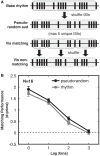Temporal structure and complexity affect audio-visual correspondence detection
- PMID: 23346067
- PMCID: PMC3550803
- DOI: 10.3389/fpsyg.2012.00619
Temporal structure and complexity affect audio-visual correspondence detection
Abstract
Synchrony between events in different senses has long been considered the critical temporal cue for multisensory integration. Here, using rapid streams of auditory and visual events, we demonstrate how humans can use temporal structure (rather than mere temporal coincidence) to detect multisensory relatedness. We find psychophysically that participants can detect matching auditory and visual streams via shared temporal structure for crossmodal lags of up to 200 ms. Performance on this task reproduced features of past findings based on explicit timing judgments but did not show any special advantage for perfectly synchronous streams. Importantly, the complexity of temporal patterns influences sensitivity to correspondence. Stochastic, irregular streams - with richer temporal pattern information - led to higher audio-visual matching sensitivity than predictable, rhythmic streams. Our results reveal that temporal structure and its complexity are key determinants for human detection of audio-visual correspondence. The distinctive emphasis of our new paradigms on temporal patterning could be useful for studying special populations with suspected abnormalities in audio-visual temporal perception and multisensory integration.
Keywords: crossmodal; information theory; multisensory; perceptual correspondence; perceptual timing; synchrony.
Figures





References
-
- Bertelson P., Radeau M. (1976). Ventriloquism, sensory interaction, and response bias: remarks on the paper by Choe, Welch, Gilford, and Juola. Percept. Psychophys. 19, 531–53510.3758/BF03211222 - DOI
-
- Calvert G. A., Spence C., Stein B. E. (eds). (2004). The Handbook of Multisensory Processes. Cambridge, MA: MIT Press
LinkOut - more resources
Full Text Sources
Other Literature Sources
Miscellaneous

